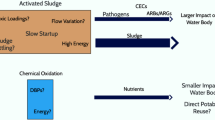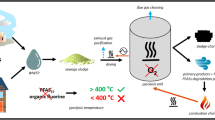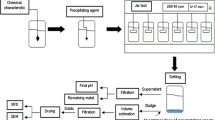Abstract
Various analyses of physico-chemical characteristics and batch tests were conducted with the sludge obtained from a full-scale electrolysis facility for treating coal mine drainage in order to find the applicability of sludge as a material for removing Zn(II) in an aqueous phase. The physico-chemical analysis results indicated that coal mine drainage sludge (CMDS) had a high specific surface area and also satisfied the standard of toxicity characteristic leaching procedure (TCLP) because the extracted concentrations of certain toxic elements such as Pb, Cu, As, Hg, Zn, and Ni were much less than their regulatory limits. The results of X-ray diffraction (XRD) and X-ray photoelectron spectroscopy (XPS) showed that the CMDS mainly consists of goethite (70%) and calcite (30%) as a weight basis. However, the zeta potential analysis represented that the CMDS had a lower isoelectric point of pH (pHIEP) than that of goethite or calcite. This might have been caused by the complexation of negatively charged anions, especially sulfate, which usually exists with a high concentration in coal mine drainage. The results of Fourier transform infrared (FT-IR) spectrometry analysis revealed that Zn(II) was dominantly removed as a form of precipitation by calcite, such as smithsonite [ZnCO3] or hydrozincite [Zn5(CO3)2(OH)6]. Recycling sludge, originally a waste material, for the removal process of Zn(II), as well as other heavy metals, could be beneficial due to its high and speedy removal capability and low economic costs.







Similar content being viewed by others
References
Abdel-Ghani, N. T., Hegazy, A. K., & El-Chaghaby, G. A. (2009). Typha domingensis leaf powder for decontamination of aluminium, iron, zinc and lead: Biosorption kinetics and equilibrium modeling. International Journal of Environmental Science and Technology, 6(2), 243–248.
Abdel-Samad, H., & Watson, P. R. (1998). An XPS study of the adsorption of lead on goethite. Surface Science, 136, 46–54.
Alwan, A. K., & Williams, P. A. (1979). Mineral formation from aqueous solution. Part 1. The deposition of hydrozinctite, Zn5(OH)6(CO3)2, from natural waters. Transition Metal Chemistry, 4, 128–132.
Angove, M. J., Wells, J. D., & Johnson, B. B. (1999). The influence of temperature on the adsorption of Cadmium (II) and Cobalt (II) on Goethite. Journal of Colloid and Interface Science, 211, 281–290.
Arias, F., & Kanti Sen, T. (2009). Removal of zinc metal ion from its aqueous solution by kaolin clay mineral: A kinetic and equilibrium study. Colloids and surfaces A: Physicochemistry Engineering, 348, 100–108.
Baer, D. R., & Moulder, J. F. (1993). High resolution XPS spectrum of calcite (CaCO3,). Surface Science Spectra, 2, l–7.
Bayramouglu, G., & Yakup Arica, M. (2009). Construction a hybrid biosorbent using scenedesmus quadricauda and Ca-alginate for biosorption of Cu(II), Zn(II) and Ni(II): Kinetics and equilibrium studies. Bioresourse Technology, 100, 186–193.
Bulusu, S., Aydilek, A. H., & Rustagi, N. (2007). CCB-based encapsulation of pyrite for remediation of acid mine drainage. Journal of Hazardous Materials, 143(3), 609–619.
Chartrand, M. M. G., & Bunce, N. J. (2003). Electrochemical remediation of acid mine drainage. Applied Electrochemistry, 33, 259–264.
Chen, A. H., Liu, S. C., Chen, C. Y., & Chen, C. Y. (2008). Comparative adsorption of Cu(II), Zn(II) and Pb(II) ions in aqueous solution on the crosslinked chitosan with epichlorohydrin. Journal of Hazardous Materials, 154, 184–191.
Darren, P. R., Bruce, B. J., & John, D. W. (1993). The effect of temperature and pH on the adsorption of copper, Lead and Zinc onto Goethite. Journal of Colloid and Interface Science, 161, 57–62.
Deliyanni, E. A., Peleka, E. N., & Matis, K. A. (2007). Removal of zinc ion from water by sorption onto iron-based nano-adsorbent. Journal of Hazardous Materials, 141, 176–184.
Dzombak, D. A., & Morel, F. M. (1990). Surface complexation modeling (hydrous ferric oxide). New York: Wiley Inter science.
Erdemoglu, N., Sahin, E., Senera, B., & Ide, S. (2004). Structural and spectroscopic characteristics of two lignans from Taxus baccata L. Journal of Molecular Structure, 692, 57.
Frost, R. L., Musumeci, A. W., Kloprogge, J. T., Adebajo, M. O., & Martens, W. N. (2006). Raman spectroscopy of hydrotalcites with phosphate in the interlayer: Implications for the removal of phosphate from water. Raman Spectroscopy, 37(7), 733–741.
Garcia-Sanchez, A., & Alvarez-Ayuso, E. (2002). Sorption of Zn, Cd and Cr on calcite. Application to purification of industrial wastewaters. Minerals Engineering, 15, 539–547.
Grosvenor, A. P., Kobe, B. A., Biesinger, M. C., & Mcintyre, N. S. (2004). Investigation of multi-plet splitting of Fe 2p XPS spectra and bonding in ion compounds. Surface and Interface Analysis, 36, 1564–1574.
Hales, M. C., & Frost, R. L. (2007). Synthesis and vibratinal spectroscopic characterization of synthetic hydrozincite and smithsonite. Plyhedron, 26, 4955–4962.
Harter, R. D. (1992). Competitive sorption of Cobalt, Copper, and Nickel ions by a calcium-saturated soil. Soil Science Society, 56, 444–449.
Jonsson, J., Persson, P., Sjobrg, S., & Lovgren, L. (2005). Schwertmannite precipitated from acid mine drainage: Phase transformation, sulphate release and surface properties. Applied Geochemistry, 20, 179–191.
Jose dos Reis, M., Silverio, F., Tronto, J., & Valim, J. B. (2004). Effects of pH, temperature, and ionic strength on adsorption of sodium dodecylbenzenesulfonate into Mg-Al-CO3 2− layered double hydroxides. Physics and Chemistry of Solids, 65, 487–492.
Jung, M. C. (1994). Sequential extraction of heavy metals in soils and a case study. Korea Society of Economic and Environmental Geology, 27, 469–477.
Kloproeeg, J. R., Hickey, L., Trujillano, R., Holgado, M. J., San Roma, M. S., Rives, V., et al. (2006). Characterization of intercalated Ni/Al hydrotalcites prepared by the partial decomposition of urea. Crystal Growth & Design, 6, 1533–1536.
Krehula, S., Popovic, S., & Music, S. (2002). Synthesis of acicular α-FeOOH particles at a very high pH. Materials Letters, 54, 108–113.
Li, Y., Liu, J. L., Wang, X. L., Wang, T., & Du, X. Y. (2008). Cu2+ and Zn2+ adsorption to synthetic iron oxides and natural iron ore powder. IEEE, 2900–2903.
Lin, S. H., & Juang, R. S. (2002). Heavy metal removal from water by sorption using surfactant-modified montmorillonite. Journal of Hazardous Materials, B92, 315–326.
Marcello, R. R., Galato, S., Peterson, M., Riella, H. G., & Bernardin, A. M. (2008). Inorganic pigments made from the recycling of coal mine drainage treatment sludge. Environmental Management, 88, 1280–1284.
Mishra, P. C., & Patel, R. K. (2009). Removal of lead and zinc ions from water by low cost adsorbents. Journal of Hazardous Materials, 168, 319–325.
Mohapatra, M., Khatun, S., & Anand, S. (2009). Adsorption behavior of Pb, Cd and Zn on NALCO plat sand. Chemical Technology, 16, 291–300.
Nita, S., Lee, Y. J., Huifang, X., et al. (2007). Ciardelli, Jean-Francois Gaillard: Role of Fe(II) and phosphate in arsenic uptake by coprecipitation. Geochimica et Cosmochimica Acta, 71, 3193–3210.
Prasad, M., Xu, H. Y., & Saxena, S. (2008). Multi-component sorption of Pb(II), Cu(II) and Zn(II) onto low-cost mineral adsorbent. Journal of Hazardous Materials, 154, 221–229.
Rodda, D. P., Johnson, B. B., & Wells, J. D. (1993). The effect of temperature and pH on the adsorption of Copper (II), Lead (II), and Zinc (II) onto goethite. Journal of Colloid and Interface Science, 161, 57–62.
Rodda, D. P., Johnson, B. B., & Wells, J. D. (1996a). Modeling the effect of temperature on adsorption of Lead (II) and Zinc (II) onto goethite at constant pH. Journal of Colloid and Interface Science, 184, 365–377.
Rodda, D. P., Wells, J. D., & Johnson, B. B. (1996b). Anomalous adsorption of Copper (II) on goethite. Journal of Colloid and Interface Science, 184, 564–569.
Sibrell, P. L., Watten, B. J., & Boone, T. (2003). Remediation of acid mine drainage at the Friendship Hill National Historic Site with a pulsed limestone bed process. In C. A. Young, A. M. Alfantazi, C. G. Anderson, D. B. Dreisinger, & A. James (Eds.), Hydrometallurgy 2003 (pp. 1823–1836). Littleton, CO: The Minerals, Metals and Material Society.
Singh, Y., Stoessel, J. P., & Wolynes, P. G. (1985). Hard-sphere glass and the density-functional theory of aperiodic crystals. Physical Review Letters, 54, 1059–1062.
Souag, R., Touaibia, D., Benayada, B., & Boucenna, A. (2009). Adsorption of heavy metals (Cd, Zn and Pb) from water using keratin powder prepared from algerien sheep hoofs. European Journal of Scientific Research, 35(3), 416–425.
Stipp, S. L. S. (1999). Toward a conceptual model of the calcite surface: Hydration, hydrolysis, and surface potential. Geochimica et Cosmochimica Acta, 63, 3121–3131.
Sudakar, C., Kharel, P., Lawes, G., Suryanarayanan, R., Naik, R., & Naik, V. M. (2007). Raman spectroscopic studies of oxygen defects in co-doped ZnO films exhibiting room-temperature ferromagnetism. Physics Condensed Matter, 19, 1–9.
Swedlund, P. J., & Webster, J. G. (2001). Cu and Zn ternary surface complex formation with SO4 on ferrihydrite and schwertmannite. Geochemistry, 16, 503–511.
Trivedi, P., & Axe, L. (2000). Modeling Cd and Zn sorption to hydrous metal oxides. Environmental Science and Technology, 34, 2215–2223.
Uygur, V., & Rimmer, D. L. (2000). Reactions of zinc with iron-oxide coated calcite surfaces at alkaline pH. European Journal of Soil Science, 51, 511–516.
Verdonck, L., Hoste, S., Roelandt, F. F., & Van der Kelen, G. P. (1982). Normal coordinate analysis of a-FeOOH A molecular approach. Journal of Molecular Structure, 79, 273–279.
Watten, B. J., Sibrell, P. L., & Schwartz, M. F. (2005). Acid neutralization within limestone sand reactors receiving coal mine drainage. Environmental Pollution, 137(2), 295–304.
Acknowledgment
This study was supported by the Korea Ministry of Environment as the GAIA (Geo-Advanced Innovative Action) Project (No. 173-091-003) and a Korea University Grant.
Author information
Authors and Affiliations
Corresponding author
Rights and permissions
About this article
Cite this article
Cui, M., Jang, M., Cho, SH. et al. Potential application of sludge produced from coal mine drainage treatment for removing Zn(II) in an aqueous phase. Environ Geochem Health 33 (Suppl 1), 103–112 (2011). https://doi.org/10.1007/s10653-010-9348-0
Received:
Accepted:
Published:
Issue Date:
DOI: https://doi.org/10.1007/s10653-010-9348-0




